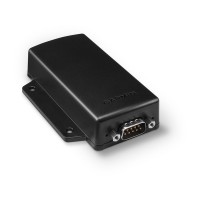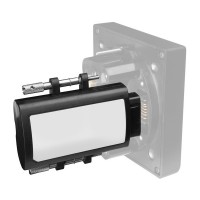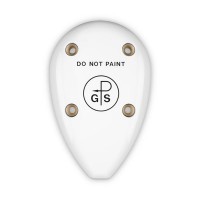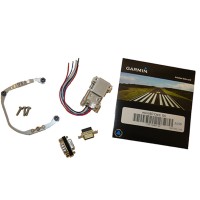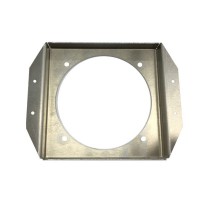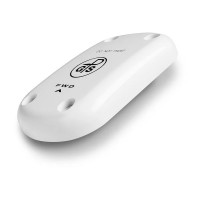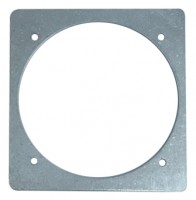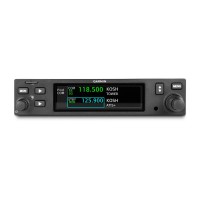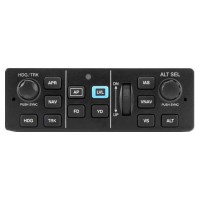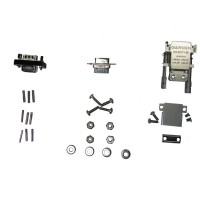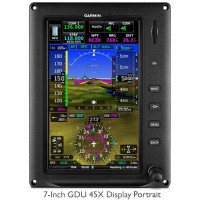Garmin G5 Experimental Kit With Custom Harness
MFR Model# ASA-00115-CU
Overview
|
Designed by our dedicated “Team X” engineering group specifically for the experimental amateur-built (EAB) and light sport aircraft (LSA) markets, the affordable G5 electronic flight instrument delivers exceptional performance, reliability and ease of installation as an all-in-one backup or primary “glass cockpit” display. The crisp, sunlight-readable 3.5” LCD fits into a standard 3-1/8” round cutout, taking up just a fraction of the space and weight previously required by conventional gyro-based instruments. G5 has 2 pilot-selectable main page formats: a PFD page and a DG (directional gyro) or HSI (horizontal situation indicator) page. VHF or GPS navigation inputs are required to drive the HSI display; for GPS interface, an optional GAD™ 29 navigation data adapter is required. By combining visual cues and data readouts once scattered across a myriad of instruments, G5 makes flight information easier to scan — so pilots can respond more quickly and intuitively to any inflight situation. Rock-solid Attitude Reference When configured as a primary attitude indicator, G5 uses solid-state AHRS reference to provide smooth, steady and reliable horizon-based pitch and roll indications. In addition to aircraft attitude, G5 will also support display of airspeed, altitude, vertical speed, slip/skid, turn rate, configurable V-speed references, barometric setting and selected altitude — as well as visual alerts upon arriving at a preselected altitude. A built-in GPS receiver and antenna (with an option for external GPS antenna connection) provides highly accurate groundspeed and ground track readouts. Plus, a dedicated rotary knob on the unit allows for easy adjustments to altitude bugs and barometric pressure settings. Gain a Clearer Sense of Direction To provide even more situational awareness, the G5 instrument can also function as a DG or HSI in your panel. When paired with an affordable GMU 11 magnetometer and select VHF Nav/Comms or GPS navigators (interfaced with optional GAD 29 navigation data adapter), G5 can serve as your primary reference source for magnetic heading, VOR/LOC guidance and/or GPS course guidance — as well as providing distance and groundspeed indications. The unit displays both vertical and lateral GPS/VOR/LOC course deviation when available (additional equipment may be required). And you can use the G5 instrument’s rotary knob to easily make and adjust course selections — or to control heading bug settings in DG installations. Because the GMU 11 is connected to the CAN bus network, a single magnetometer can supply heading information to 2 G5 units simultaneously. Dual Displays Double Your Options By installing dual G5 displays in your panel, you not only gain dedicated instruments for attitude reference and directional gyro/HSI guidance — you also gain the advantages of backup redundancy with dual ADAHRS and reversionary display capability. In such installations, a secondary G5 can revert to display attitude information (consolidated with heading indication) in the unlikely event of a failure in the primary attitude indicator position. For added “get home” protection, each G5 display is available with an optional backup lithium-ion battery, which can provide up to 4 hours of emergency operation in case of an aircraft electrical outage or shutdown. And if you use one of our aera® series aviation portables¹ as a backup, you can fly with battery-powered moving map navigation guidance — as well as the G5 instrument’s flight display information — to make that aircraft electronics outage virtually a non-event. It’s Even Better with G3X When used as a backup instrument for your G3X, G3X Touch or other compatible glass display system, G5 provides a full range of supplemental EFIS capabilities. So, if needed, it can be used to maintain the majority of your flight display and autopilot control functions — including the ability to fly coupled GPS approaches. G5 will also provide backup ADAHRS reference to the primary displays. So whatever happens, with a G5 electronic flight instrument in your system, you can count on a wider range of options in virtually any shutdown scenario. Stand-alone Flight Instrument with Autopilot G5 may be installed with a GMC 305 or GMC 307 autopilot control panel and up to 3 GSA 28 smart servos to perform as a stand-alone flight instrument with integrated autopilot functions. In addition, the GTN™ 750/650 series2 (and legacy navigators2) or a Garmin portable GPS such as aera 660, aera 795 or aera 796 may be connected to the serial port on G5, enabling the autopilot to couple laterally to the flight plan and vertically to support VNAV descents to pattern altitude. Other lateral and vertical autopilot modes selectable from GMC 305 or GMC 307 include heading, pitch, roll, altitude hold, vertical speed hold and airspeed hold. Even the control panel’s level (LVL) mode button is supported to engage the autopilot and restore the aircraft to level flight at the press of a button. Learn More About G5 A highly flexible and scalable solution designed to fit a broad range of panels and configurations, the G5 electronic flight instrument brings new levels of confidence and situational awareness to your experimental/light sport cockpit. For added peace of mind, your EFIS investment is covered by our industry-leading Garmin warranty — and backed by our No. 1-ranked product support team. |
WARNING: Cancer and Reproductive Harm - www.P65Warnings.ca.gov. |
Specifications
- Electrical: 14 or 28 VDC aircraft power
- Unit size: 3.4"W x 3.6"H x 3.0"D (86.4 x 91.4 x 76.2 mm)
- Weight: 13.3 oz (377.0 g) unit
- Display size: 3.5" diagonal (88.9 mm diagonal)
- Display resolution: 320 x 240 pixels (QVGA), LED backlit color LCD
- Receiver: High-sensitivity GPS
- Maximum indicated airspeed: 300 kts
- Altitude range: -1,400 – +30,000 ft
- Vertical speed range: ± 20,000 ft/minute
- Pitch/roll range: ±360°
- Backup battery (optional): Rechargeable lithium-ion
- Battery life: Up to 4 hours
Documents
- CAD Panel Cutout (DXF)
- The latest revision of the installation manual may be obtained at fly.garmin.com.
Videos
Reviews
Used the G5 since 2017. I now own three of them in a couple airplanes with no issues. My airplanes are far from hanger queens and stay out in the extreme Northern Canada weather. The only issue was on a friends airplane, his backup battery failed. Again we leave are planes in the -40 and colder weather. Reliable and easy to see. Highly Recommended
Works as expected except for data logging. The G3X system creates a new log file each time the system is booted and log files are all a manageable size. The G5 maintains only one log file with records being appended. The G5 CSV log file soon becomes too large to be imported into Excel. I hope Garmin will change data logging so a new log file is created for each boot, just as is done in G3X experimental system.
Promised delivery date was spot on and it arrived in excellent condition. My installation integrated the G5 with the existing G3x system which automatically configured most of the setup. I found the G5 display tracked very well with the G3, was bright with excellent contrast, and very readable in sunlit conditions.
Worth every penny... especially considering the huge price break for an experimental unit. Replaced my vacuum DG with this G5 (plus the magnetometer). Easy to install, not very susceptible to interference (even with the magnetometer mounted in my wingtip next to my strobe), and works great. Never set a DG again!
Very pleased with the G5 unit. Very impressive and wish I could afford to install a 2nd one.
I have two of these installed, one in an RV-8, the other in a Lancair. They work perfectly, are easy to read and use. The attitude indication is more accurate than any of my other EFIS AHRS units. Firmware updates are easy via the SD card and they keep making them better and better. Highly recommended!
Replaced a Tru Trac Gemini in my RV-6 that tru trac does not support anymore since King bought them. This is so much better. The gemini would only display the VS in the pitch axis, so setting on the ground in my tail dragger it showed a level flight attitude. Also it did wierd things in the roll axis beyond 60 degrees The garmin is so much smoother and the display is much crisper and easier to read in sunlight. Great product easy to wire and set up for stand alone operation.
Lost my vacuum pump and decided to apply the $500 towards a G5 which relegated my AI, DG, pump, regulator and suction gauge to the surplus bin. A net change of -8 lbs. The G5 is wonderful, very simple to install and pairs nicely with the Aera 660. Initial set up was super easy. The Spruce harness is well constructed but not marked. You need a meter to determine the pin out. The HSI feature nicely displays the Aeras nav data and makes the Aeras marginal VNAV feature very usable. Ill be buying a second G5 as a dedicated HSI/backup PFD.
Replaced a vacuum-driven attitude indicator in my RV-6 with a G5. OMG what a lovely little instrument it is. Ive been using it for 6 months now. Very comprehensive feature set for such a small and relatively cheap package. The only thing its missing which I think it should have is a g-meter display (it has enough sensors its only software and screen real estate) So impressed with it, Im about to buy my second unit to replace the vacuum-driven DG, so I can run it as a HSI and completely eliminate the vacuum system and mechanical CDI from the aircraft. Two G5s driven by a GNS430W coupled to an autopilot is a remarkably cheap and featureful way to turn a steam-gauge sixpack E/AB aircraft into a pretty capable IFR platform.
Q&A
Please note, Aircraft Spruce ®'s personnel are not certified aircraft mechanics and can only provide general support and ideas, which should not be relied upon or implemented in lieu of consulting an A&P or other qualified technician. Aircraft Spruce ® assumes no responsibility or liability for any issue or problem which may arise from any repair, modification or other work done from this knowledge base. Any product eligibility information provided here is based on general application guides and we recommend always referring to your specific aircraft parts manual, the parts manufacturer or consulting with a qualified mechanic.
Yes. The optional battery is part # 11-14314.
An internal GPS antenna is included so a remote GPS antenna is not necessary. However, the GA 35 GPS antenna can be installed if preferred.
No. The Garmin G5 does not AOA capabilities.
|The front panel dimensions are 3.42" X 3.6".
This version, part # 11-14312, is intended for use in experimental (homebuilt) aircraft only. For certified aircraft, please see part # 11-14579 or 11-14582.
It will drive a GSA 28 servo (Garmin G3X servo) via the can-bus input/output on the G5.
Yes, the G5 will function properly in a tail dragger.
No, the Garmin G5 does not read volts.
In the STC'd version and experimental there is a compass / heading strip on the top of the display. This is based on built-in AHRS and GPS info.
The G5 can utilize a GMU 11 magnetometer as a standalone solution for magnetic heading (without a G3XT). The unit will revert to GPS TRK only if Magnetic heading is lost (GMU failure).


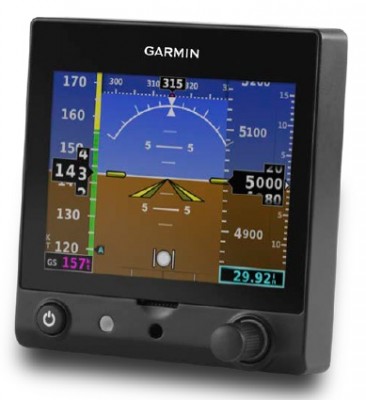
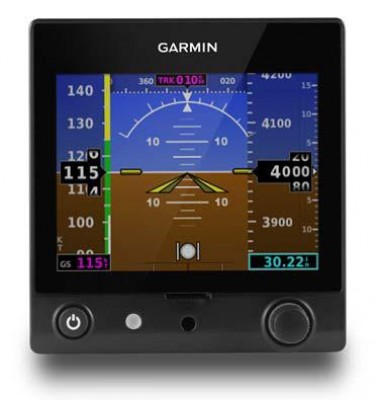
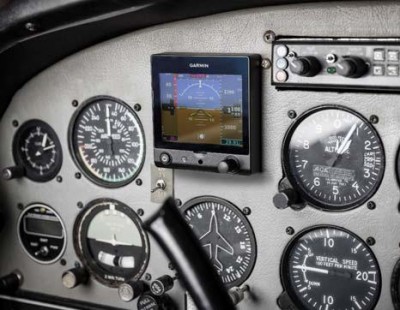
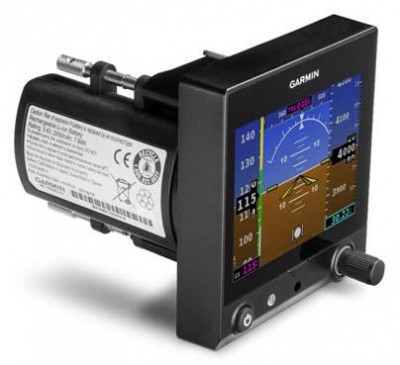
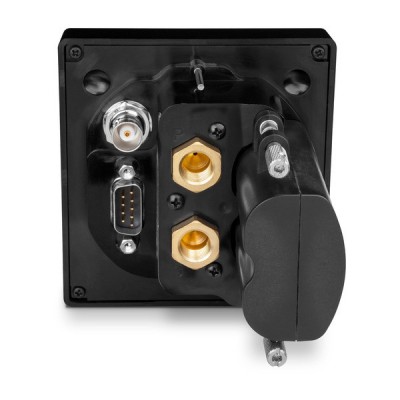










 FREE Shipping
FREE Shipping

